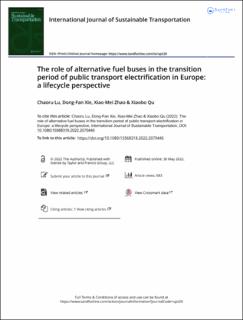| dc.contributor.author | Lu, Chaoru | |
| dc.contributor.author | Xie, Dong-Fan | |
| dc.contributor.author | Zhao, Xiao-Mei | |
| dc.contributor.author | Qu, Xiaobo | |
| dc.date.accessioned | 2023-05-02T14:43:32Z | |
| dc.date.available | 2023-05-02T14:43:32Z | |
| dc.date.created | 2022-06-07T12:53:20Z | |
| dc.date.issued | 2022 | |
| dc.identifier.citation | International Journal of Sustainable Transportation. 2022, 1-13. | en_US |
| dc.identifier.issn | 1556-8318 | |
| dc.identifier.issn | 1556-8334 | |
| dc.identifier.uri | https://hdl.handle.net/11250/3065842 | |
| dc.description.abstract | In alignment with climate change, the European Union endeavors to accelerate the electrification progress of the public transit system. In particular, Copenhagen in Denmark and Oslo in Norway develop a blueprint to have 100% public transit electrification by 2030 and 2028, respectively. In this study, the lifecycle approach is applied to explore the role of electric buses in the electrification progress of the public transport system in different European countries. To better model the energy/fuel consumption, we integrate the theoretical model of human thermal comfortable temperature into our proposed framework. We take into account the effects of weather, the daily operation characteristics, and the energy mix of different European counties, and evaluate the lifecycle environmental and economic performance of electric buses. The result shows that the public transportation system with both hybrid and electric buses can be good compensation between financial and environmental needs instead of using electric buses to replace all the conventional buses. Moreover, the operational plan of the public transportation system mixed with electric and hybrid buses may be adjusted according to the seasonal temperature variation so as to maximize the environmental benefits. Considering the different economic and environmental scenarios of energy sources, some EU countries would be able to reduce or remove the incentives for electric buses. | en_US |
| dc.language.iso | eng | en_US |
| dc.publisher | Routledge | en_US |
| dc.rights | Attribution-NonCommercial-NoDerivatives 4.0 Internasjonal | * |
| dc.rights.uri | http://creativecommons.org/licenses/by-nc-nd/4.0/deed.no | * |
| dc.title | The role of alternative fuel buses in the transition period of public transport electrification in Europe: a lifecycle perspective | en_US |
| dc.type | Peer reviewed | en_US |
| dc.type | Journal article | en_US |
| dc.description.version | publishedVersion | en_US |
| cristin.ispublished | true | |
| cristin.fulltext | original | |
| cristin.qualitycode | 1 | |
| dc.identifier.doi | http://dx.doi.org/10.1080/15568318.2022.2079445 | |
| dc.identifier.cristin | 2029859 | |
| dc.source.journal | International Journal of Sustainable Transportation | en_US |
| dc.source.pagenumber | 1-13 | en_US |
| dc.relation.project | Norges forskningsråd: 299078 | en_US |
| dc.relation.project | Direktoratet for høgare utdanning og kompetanse: UTF-2020/10115 | en_US |
| dc.relation.project | Energimyndigheten: 2018-009396 | en_US |
| dc.relation.project | National Natural Science Foundation of China: 71961137008 | en_US |

